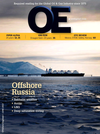
Page 49: of Offshore Engineer Magazine (Jun/Jul 2013)
Read this page in Pdf, Flash or Html5 edition of Jun/Jul 2013 Offshore Engineer Magazine
Offshore Russia were especially important, since good weather was needed for lifts. During less-optimal weather, personnel con- centrated on subsea work.
The meteorologists were also asked to quantify the probability of abnormal weather occurring, such as the onset of sea fog or rogue waves, and were also responsible for preparing typical marine weather charts.
Onsite advantage
Brozefsky told OE that the advantage of onsite forecasting is that the meteo- rologist can observe and interpret any subtle change in weather and update forecast immediately, based on the cur- rent trends.
Fog obscures the view of the Arkutun-Dagi GBS from the vantage point
The forecasters relied on shipboard
Lewek Crusader Photo by F. Kredensor of the . anemometers and weather buoys (wind, current, sea surface temperature), and the weather buoy. The onsite meteo- closest major airport, and Wakkanai, used markings on the GBS legs to rology work concluded the frst week the northernmost city on Hokkaido record wave height. Currents were gen- of September 2012. Says Brozefsky: Island, is closest by sea. Travel from erally light, one-half to one knot. “Working offshore can be unpredict- Wakkanai to the Sakhalin operations
Meteorology reports included a able. You have to be fexible.” site required 2.5 to 3 days by ship. All- weather synopsis, graphs, and a table Nippon Air (ANA) offers service from of wind and wave forecasts for 5-7 Safety, logistics Wakkanai.
days out. A beneft of six-hour report The WWT forecasters’ main tools were Another mobilization point was spacing was that there was less-dra- long-range models, laptops, and per- Vostochny Port, the largest port in the matic fuctuation between forecasts. sonal protective equipment (PPE)! Russian Far East, in Vrangel, on the
Visibility varied through the season. ENL places the highest emphasis coast of the Sea of Japan. The Arkutun-
There was fog almost every day in July, on process safety. Heerema is equally Dagi GBS was constructed in a drydock triggered by warm and moist south- diligent about personal and specifc at Vostochny. This deepwater, ice-free erly air blowing from the northwest safety. Overall, WWT said there was port, at 42° 46’ N latitude, operates
Pacifc; its dew point was higher than good oversight, with an environment year-round and encompasses the the colder sea surface temperature, The that encouraged reporting, and a “see Special Sea Oil Terminal in Kozmino weather was mostly sunny through something, say something” rule. Bay, Primorsky Krai. Vostochny is at
August, as sea surface temperature Planes and ferries travel between the eastern end of the Trans-Siberian increased and dry air blew east off the Sakhalin and Hokkaido, and the two Railway, and Kozmino is the terminal
Asian continent. regions have good relations, with sev- point of the Eastern Siberia – Pacifc eral towns on Sakhalin twinned with Meridian pipeline.
With good visibility, Kredensor noted towns on Hokkaido. that those aboard the Lewek Crusader
Most of the support operations were Online Exclusive: Sakhalin photo could see both the Orlan and Chayvo staged out of Japan; Sapporo has the essay, OEdigital.com platforms. In particularly clear condi- tions, it was also possible to see the top mast of the Molikpaq drilling and production platform, an Arctic caisson
Sakhalin II exports LNG operated by Sakhalin Energy Investment
Sakhalin-II is an integrated, export-oriented built at Prigorodnoye in Aniva Bay, 13 km
Addendum: Sakhalin-2
Co. Ltd. on the Piltun-Astokhskoye oil and gas development, and Russia’s frst (8.1 mi) east of Korsakov. The oil export feld, part of Sakhalin-II development.
offshore gas project. It handles production terminal is east of the LNG plant on Aniva
Kredensor noted that weather moves from Piltun-Astokhskoye oil feld and the Bay [see cover photo]. faster in the Polar Regions; stronger
Lunskoye natural gas feld in the Okhotsk Oil and natural gas now account for
Sea, and is managed and operated by 95% of Sakhalin’s exports. The frst LNG jet streams cause systems to change
Sakhalin Energy Investment Co. Ltd. Share- train began shipping in 2000, with 20-year rapidly, so forecasting models need holders of Sakhalin Energy include Gazprom contracts in place, and 60% of production constant revision. In August, two decay- (50% +1 share); Shell (27.5% - 1 share); heading to Japan.
ing tropical systems swept into the Sea
Mitsui (12.5%); and Diamond Gas Sakhalin, When the project reaches full capacity, it of Okhotsk from the northwest Pacifc, a subsidiary of Mitsubishi (10%). is projected to be able to supply 5% of the causing a few days’ delay.
The Sakhalin-2 LNG plant is Russia’s frst, world’s gas supply.
•
Before leaving location, they pulled oedigital.com June 2013 | OE 51
Russia2-Sakhalin.indd 51 5/29/13 4:23 PM

 48
48

 50
50